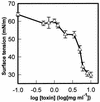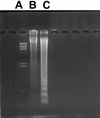Burkholderia cepacia produces a hemolysin that is capable of inducing apoptosis and degranulation of mammalian phagocytes
- PMID: 9573086
- PMCID: PMC108160
- DOI: 10.1128/IAI.66.5.2033-2039.1998
Burkholderia cepacia produces a hemolysin that is capable of inducing apoptosis and degranulation of mammalian phagocytes
Abstract
Burkholderia cepacia is an opportunistic pathogen that has become a major threat to individuals with cystic fibrosis (CF). In approximately 20% of patients, pulmonary colonization with B. cepacia leads to cepacia syndrome, a fatal fulminating pneumonia sometimes associated with septicemia. It has been reported that culture filtrates of clinically derived strains of B. cepacia are hemolytic. In this study, we have characterized a factor which contributes to this hemolytic activity and is secreted from B. cepacia J2315, a representative of the virulent and highly transmissible strain belonging to the recently described genomovar III grouping. Biochemical data from the described purification method for this hemolysin allows us to hypothesize that the toxin is a lipopeptide. As demonstrated for other lipopeptide toxins, the hemolysin from B. cepacia was surface active and lowered the surface tension of high-pressure liquid chromatography-grade water from 72.96 to 29.8 mN m(-1). Similar to reports for other pore-forming cytotoxins, low concentrations of the hemolysin were able to induce nucleosomal degradation consistent with apoptosis in human neutrophils and the mouse-derived macrophage-type cell line J774.2. Exposure of human neutrophils to higher concentrations of toxin resulted in increased activities of the neutrophil degranulation markers cathepsin G and elastase. Based on the results obtained in this study, we suggest a role that allows B. cepacia to thwart the immune response and a model of the events that may contribute to the severe inflammatory response in the lungs of CF patients.
Figures






References
-
- Abe M, Nakazawa A. Characterization of hemolytic and antifungal substance, cepalycin from Pseudomonas cepacia. Microbiol Immunol. 1994;38:1–9. - PubMed
-
- Burns J L. Characterization of invasion of epithelial cells by Pseudomonas cepacia. Pediatr Pulmonol Suppl. 1992;8:201. . (Abstract.)
-
- Butler S L, Nelson J W, Govan J R W. Abstracts of the Eleventh International Cystic Fibrosis Congress. 1992. Cell surface characteristics of Pseudomonas cepacia isolates from patients with cystic fibrosis, abstr. TP8; p. 149.
-
- Debentzmann S, Roger P, Puchelle E. Pseudomonas aeruginosa adherence to remodeling respiratory epithelium. Eur Respir J. 1996;9:2145–2150. - PubMed
Publication types
MeSH terms
Substances
LinkOut - more resources
Full Text Sources
Other Literature Sources
Research Materials

